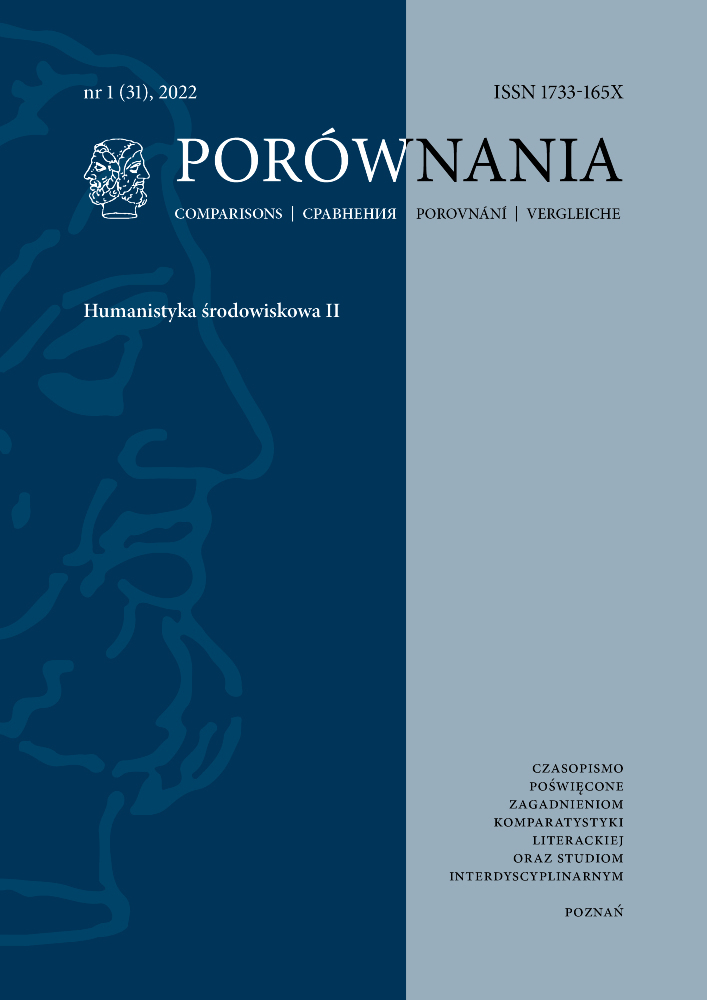Abstract
In contemporary Hungarian literature, an increasingly important role is played by post-humanist-anthropocene forms of literary expression, the starting point of which is biological operations performed on the body. The bodily transformations that change the anthropological and evolutionary picture of man are accompanied by new biological constructs and power relations, as a result of which animal life forms acquire hybrid identities. Three Hungarian novels are discussed in the work: My Hero’s Square (2000) by Lajos Parti Nagy, A patkány éve [Year of the Rat] (2013) by Imre Bartók, Irha és bőr [Hide and Skin] (2019) by Anita Moskát. Their analysis is set in the context of posthumanism, ecocriticism and postmodernism.
References
Agamben, Giorgio. L'Aperto. Torino: Bollati Boringhieri Editore, 2002.
Balassa, Péter. Törésfolyamatok. Debrecen: Csokonai, 2001.
Bartók, Imre. A patkány éve. Budapest: Libri, 2013.
Bodor, Béla. "Élettér légköbméterben." Holmi 4 (2001): 524-530.
Darida, Veronika. "Poszthumán színterek." Helikon 4 (2018): 496-505.
Deleuze, Gilles, Félix Guattari, and Kafka. A kisebbségi irodalomért. Trans. Judit Karácsonyi. Budapest: Qadmon, 2009.
Fukuyama, Francis. Our Posthuman Future. New York: Farrar, Straus and Giroux, 2002.
Gramsci, Antonio. Filozófiai írások. Trans. Rozsnyai Ervin. Budapest: Kossuth, 1970.
Gramsci, Antonio. Válaszút a pedagógiában. Trans. Bólyai Imréné. Budapest: Akadémiai, 1979.
Halberstam, Judith, Ira Livingston. "Introduction: Posthuman Bodies." Posthuman Bodies. Eds. Judith Halberstam, Ira Livingston. Bloomington and Indianapolis: Indiana University Press, 1995. 1-19.
Horváth, Márk, Ádám Lovász, and Márió Z. Nemes. A poszthumanizmus változatai - Ember, embertelen és ember utáni. Budapest: Prae, 2019.
k szonja. "Sötét szárnyak suhogása." Az Irodalom Visszavág 7 (2000): 173-176.
Keresztes, Balázs. "Kultúrtechnika." Média és kultúratudomány. Eds. Beatrix Kricsfalusi, Ernő Kulcsár Szabó, Gábor Tamás Molnár, Ábel Tamás. Budapest: Ráció, 2018. 302-307.
Keserű, József. "Nem őznek való vidék: Moskát Anita: Irha és bőr." Opus 4 (2019): 74-84.
Kiss, Kata. "A gondolkodás képének átformálása. Poszthumán praxis a 21. századi feminizmusban." Helikon 4 (2018): 452-465.
Losoncz, Márk. "Mi jöjjön a poszthumanizmus után?" Prae (2020), https://tinyurl.com/yckmhkac. Accessed 22 Sept. 2021.
Margócsy, István. Hajóvonták találkozása. Budapest: Palatinus, 2003.
Moskát, Anita. Irha és bőr. Budapest: Gabo, 2019.
Nagy, Péter H. "A fajzatok eredete." Alföld 11 (2019): 130-137.
Nemes, Márió Z. "Poszthumanizmus." Helikon 4 (2018): 371-373.
Spivak, Gayatri Chakravorty. "Szóra bírható-e az alárendelt?" Trans. Mánfai Alice és Tamay László. Helikon 4 (1996): 450-483.
Sükösd, Mihály. "Galambapokalipszis." Mozgó Világ 9 (2000): 110-112.
License
Utwory opublikowane w czasopiśmie „Porównania”, na platformie Pressto należącej do Uniwersytetu im. Adama Mickiewicza w Poznaniu są udostępniane na licencji Creative Commons Uznanie autorstwa - Bez utworów zależnych 4.0 Międzynarodowe (CC BY-ND 4.0)
Tym samym wszyscy zainteresowani są uprawnieni do korzystania z utworów opublikowanych pod następującymi warunkami:
-
uznania autorstwa — czyli obowiązek podania wraz z rozpowszechnianym utworem informacji o autorstwie, tytule, źródle (odnośniki do oryginalnego utworu, doi) oraz samej licencji
-
bez utworów zależnych — remiksując, przetwarzając lub tworząc na podstawie utworu, nie wolno rozpowszechniać zmodyfikowanych treści.
-
brak dodatkowych ograniczeń — nie można korzystać ze środków prawnych lub technologicznych, które ograniczają innych w korzystaniu z utworu na warunkach określonych w licencji.
Uniwersytet im. Adama Mickiewicza w Poznaniu zachowuje prawo do czasopisma jako całości (układ, forma graficzna, tytuł, projekt okładki, logo itp.).
Autor zachowuje prawa majątkowe, ale udziela zgody Uniwersytetowi im. Adama Mickiewicza w Poznaniu na wykorzystanie dzieła. Autorzy tekstów zakwalifikowanych do publikacji proszeni są o wypełnienie podpisanie i przesłanie umowa (PL) agreement (EN)
Agreement for granting a royalty-free license to works with a commitment to grant a CC sub-license





